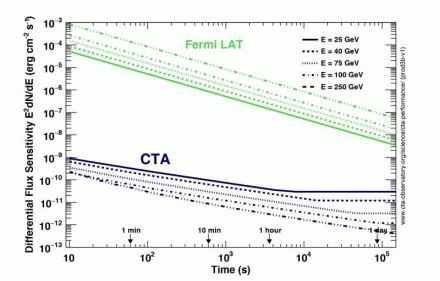
The sensitivity of CTA is defined as the lowest possible detectable flux of high-energy photons within a given amount of time (see Figure above). The CTA observatory will be about a factor of ten more sensitive than existing instruments, and at the same time cover a much larger energy range (from 20 GeV to beyond 300 TeV). CTA will be able to measure the energy and direction of incoming gamma rays with much higher accuracy, allowing high-precision studies of gamma-ray emitters like Supernova Remnants.
The performance characterization of the future CTA is one of the main activities of the DESY group. The experience of DESY scientists in gamma-ray astronomy, with history in H.E.S.S., MAGIC and VERITAS, allows for the development and application of sophisticated reconstruction algorithms to Monte Carlo simulations of CTA. The computing infrastructure at DESY supports this projects, providing thousands of computing cores and more than a petabyte of storage.




